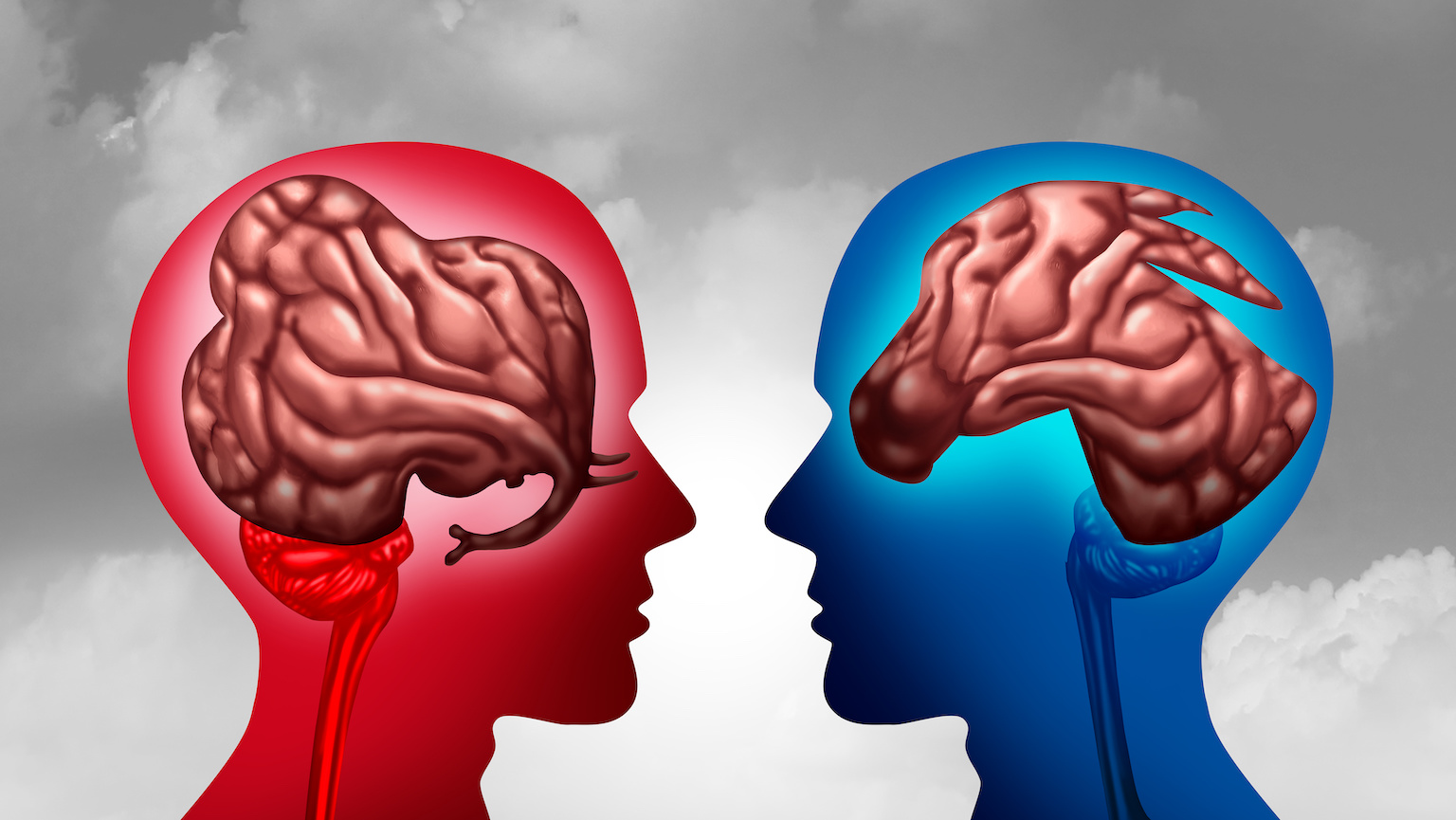What the difference in brain structure between liberals and conservatives? And where do our political convictions come from: rational deliberation, or biological determinism?
Gail Saltz: So I think what’s really fascinating is that there have been a number of recent studies looking at brain structural differences between liberals and conservatives. And what’s been found in several studies is that liberals tend to have a larger anterior cingulate gyrus. That is an area that is responsible for taking in new information and that impact of the new information on decision making or choices. Conservatives tended on the whole to have a larger right amygdala. Amygdala being a deeper brain structure that processes more emotional information - specifically fear based information. So it’s really responsible for the flight or fright response. And this isn’t everybody. It’s not black and white and of course then, you know, what about all of the people in the middle? But basically the study showed that if you just based it on brain structural size different you could predict who would be a conservative and who would be a liberal with frequency of 71.6 percent.
71.6 percent is a pretty high ability to predict who is a conservative and who is a liberal just from brain structure. When you look at what your parents were in terms of predicting what you might be in terms of conservative versus liberal, that enabled you to predict in studies at a rate of 69.5 percent. So very close. Not quite as good and why is that interesting? It’s because the brain is plastic. So the question as to whether you have a brain structure to start with that informs whether you will be a liberal or conservative or whether the formation of certain thoughts from your parents for example shapes your brain structure. Because the brain is plastic and ever changing, particularly in youth. So does thinking certain thoughts or predominantly let’s say utilizing your right amygdala versus your anterior cingulate gyrus inform the growth of those areas and therefore help you predict later who is liberal and who is conservative.
So in terms of interpreting the meaning of different sized structures for a liberal versus a conservative I think you have to look at what that area is predominantly responsible for. So for instance for conservatives if you’re right amygdala is enlarged and that’s the fear processing area you would expect maybe choices or decisions or character and personality to be more informed by a response to a fearful situation. So for example conservatives in fact in personality studies do tend to rate higher in areas of stability, loyalty, not liking change, being more religiously involved in terms of decision making, having that rate higher for them in making certain choices. And if you look at liberals from a personality character standpoint you’re going to find stronger ratings in terms of liking change wanting to actually base decision making on new information, on science information. And so those differences are not surprising in light of these brain structural differences.
Being a liberal or being a conservative really is not black and white. It’s really a bell shaped curve where, you know, someone who considers themselves conservative may be far less conservative so to speak than someone else who still calls themselves a conservative. And that bell shaped curve continues all the way through where in the middle there may be a large group that calls themselves independents.
What we don’t know is whether that has to do with differences in brain structure and so would we see in independents, no one’s does that study to say oh, independents don’t show any differences in brain structure or any differences in say risk taking reaction. So we don’t know for sure what that means but I think it’s fair to say that even when we looked at differences in brain structure with a reliability of 71.6 percent that still leaves, you know, a very larger number that don’t fit into that category. So, you know, where do they fall out? Are they more likely to be independents in their mind? We don’t know the answer to that but certainly, you know, these are not hard and fast rules. This is not diagnostic science and people who are independent obviously have certain characteristics I’ll say of both sides are somewhere just like they sound in the middle.
I think by understanding what’s going on structurally in the brain and functionally in the brain we can better understand what informs people’s very strong opinions that ultimately inform our political system, right. Because it’s one person, one vote. And in trying to change people’s minds I think everybody has to look at what’s behind the ability to change a mind. Is it really changeable?
When we look at voting and changing minds and say political advertising you have to recognize that all of that new information always comes in through the prism of your brain. Which means that what I say to you versus you may be heard differently even though I’ve said the same thing. So it comes in through the prism of does what you said make me nervous and afraid and therefore I’m going to resort to my old standby I don’t want to change my decision? Or am I going to hear the same information and say oh, that’s novel. I have a receptivity to novel information. Therefore that’s interesting to me and I’m going to think about whether I might change my mind based on that new information.
I think that’s what the science is basically saying to us that there are going to be some people who are going to hear the information and retreat to their original thinking. And other people are going to hear new information and say that really does change my mind.
If we’re trying to have a society that will work in its own best interest let’s say then we do want to be able to communicate with one another. And so if you’re a liberal and say you want to talk to a conservative about gay marriage you want to have in your mind how it might still speak to loyalty, stability and religious belief in some way. You want to have those ideas inform your communication as opposed to simply saying but, you know, this percentage of the population is homosexual and therefore, you know, we should consider whether everybody should have those same rights. And, you know, science shows it’s not a choice. It’s simply a fact you’re gay or not gay. And therefore shouldn’t those people have the same rights? That’s not the best way to appeal perhaps to a conservative on this issue.
You want to appeal to them in terms of how for example marital rules or history might be maintained and not really altered for those who are in let’s say a “traditional marriage.” How it won’t interrupt the fabric for example of their lives, of the rules that they adhere to. Those kinds of things would be more appealing to them whether or not that might be the most appealing argument to you as a liberal.
The truth is a conservative is more likely to be able to appeal to a liberal using novel new information that is science based and showing certain facts and allowing for it not necessarily to be purely religiously based. That not be the rule system so to speak. By being empathically understanding. And by that I don’t mean sympathetically understanding. I mean truly being able to stand in the other person’s shoes and have some insight into where their brain is directing them and appealing to that argument. So if you are a conservative you will want to appeal with new information because liberals are more novelty seeking potentially. And often science based is a good way to present new information.
Part of what’s difficult in terms of what I’m seeing now is that actually people are tending to double down on their own style and what appeals to their own group of thinkers. And that is increasingly preventing the kind of communication that would be important to our future so that we can’t so to speak cross the aisle because it would require trying on for size the thought pattern of the other group. And that’s hard to do. Let me say that is difficult to do. So if your amygdala is screaming at you, you know, run for the hills or double down and fight it’s hard to say well, let me take a step back and not have a fear based reaction but instead present the science or present the new information.
A good example would be that of gun ownership. If I speak about gun ownership to a liberal group they automatically have thoughts probably about, particularly if they’re in an urban area, crime and danger because statistically that is what they have been privy to. The information has been given to them about how many homicides are committed, who is, you know, dying by gun violence, et cetera.
If I speak about gun ownership to a conservative group they are more likely in their loyal stable way to think about a sportsmanship, hunting with family particularly again if they’re in a rural area. Because that is what they grew up with, that is what has been stable for them, that is the memory that they have about guns. And so you can see how that’s coming from two completely different directions perhaps the same word, gun. And that it is hard to stand in the shoes for example of the other group so that you can come to make decisions about it.
So, for example, the CDC has been prevented from doing any research so that we could have new science about gun violence as a public health issue by actually the conservative political group has said, you know, you can’t do research on this area. We won’t call it a public health issue and therefore you’re prevented from getting dollars and prevented from having research into gun violence per se. And that comes probably from a fear position that if there is any new information that sways opinion we will lose our loyal standing to something that we firmly believe in and harks back to very pleasurable comforting memories from earlier life. So it’s very complicated in a certain kind of way. You know the liberal group is wanting there to be this research not necessarily to take guns away but to say we’d like to see the science to validate whether or not certain things about guns are good for us or not good for us.
The most recent study looking at what is going on in the brain in terms of politics predicted with the greatest value being able to identify a conservative versus a liberal 82.6 percent. And this was a look at brain activity which is different. You put someone in a functional MRI which his different than just taking a picture. It picks up activity in a certain area of the brain. And found that when you have them do a risky behavior and look at their activity in their brain conservatives were more likely to light up in the fright and flight response area, the amygdala, and liberals were more likely to light up in areas that have to do with social awareness.
Again you could see how therefore this difference would inform what comes to the mind of either a liberal or a conservative while either involved in a risky behavior or even something that’s happening external to them but feels like it might impact them in a risky way. And that was actually even more predictive than looking at structure of the brain or what your parents were in terms of liberal versus conservative.





